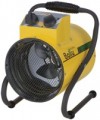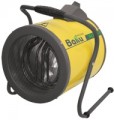Max. thermal output
The highest heating power produced by an industrial heater.
The maximum area that the unit can effectively heat directly depends on this parameter (see below). Even if it is not indicated in the specs, it can be approximately determined from the calculation that for heating 1 m² of a room with a standard ceiling height of 2.5 m and good thermal insulation will require 100 W of thermal power. If the ceiling height is significantly different, then the power required for heating can already be withdrawn from the volume of the room — every 2.5 cubic metres of volume will require the same 100 W (and the volume is found by multiplying the area by the height of the ceiling). There are also more complex formulas for the most accurate calculation, taking into account the degree of thermal insulation, the temperature difference between inside and outside the room, etc.; they can be found in special sources.
Note that in electric models (see "Power supply"), the maximum thermal power, in addition to all of the above, also determines the total power consumption of the unit: the power consumption (see below) cannot be less than the thermal output (usually, it is somewhat higher due to for the removal of part of the energy for the operation of the fan). In devices with a water circuit, the actual thermal output depends on the temperature of the coolant at the inlet and outlet. Therefore, in the characteristics, a certain standard value is usually indicated, and in t...he notes, it is specified for which temperatures it is relevant (for example, 90 ° / 70 °).
Max. heating area
A very conditional parameter that slightly characterizes the purpose by the size of the room. And depending on the height of the ceilings, the layout of the room and the equipment, the actual values may differ significantly. Nevertheless, this item represents the maximum recommended area that the heat gun can effectively heat.
When determining the maximum area, usually, a universal formula is used that is valid for all heaters: 1 m² of floor space in a room with a standard ceiling height of 2.5 m requires 100 W of thermal power. Therefore, if the ceiling height differs markedly from this value, the actual heating area should be recalculated; for more details on scaling, see “Maximum thermal output".
Increase in air temperature (ΔT)
This parameter describes the difference between the air temperature at the inlet to the heater and the outlet temperature — in other words, by how many degrees the air temperature rises when passing through the unit. The higher ΔT, the hotter the outgoing air will be and the more attentively it is necessary to observe safety measures (do not place the device near flammable and heat-sensitive materials, prevent people from being in the immediate vicinity of the gun exit, etc.).
Rated current
The current consumed by the heat gun during normal operation. This parameter is useful primarily for assessing the load on the mains that occurs during the operation of the unit and organizing the appropriate connection. In particular, the rated current of the fuse installed in the connection circuit cannot be lower than the total rated current of the connected load — otherwise, the power will be turned off. Heat guns (primarily electric, see "Power supply") are quite high consumption consumers in terms of current.
Power consumption
The power consumed by the electrical components of the industrial heater during operation.
This parameter allows, first of all, to assess the load on the power grid and the suitability of the available power for the normal operation of the unit. It is relevant for all types of modern industrial heaters (see "Power supply"). However, it is worth noting that in some electric models, the power consumption is indicated for the ventilation mode. In this mode, the heating element is not activated, and the power consumption is extremely low — a few tens of watts. In such cases, the total power can be estimated from the maximum thermal output (see above) — in electrical models, these parameters practically do not differ from each other.
Airflow
The maximum amount of air that an industrial heater can pass through itself in a certain time.
This parameter is associated with an increase in air temperature (see above): at constant power, higher performance usually corresponds to a smaller temperature difference. Accordingly, a more efficient industrial heater will heat the entire volume of the room faster, but the heating temperature will be lower. So, it is worth choosing according to this parameter, taking into account what is more important for you — a large temperature difference or a high heating rate.
Power adjustment
The method of adjusting the heating power provided in the design of the heat gun.
- Stepped. Step adjustment assumes the presence of several fixed power values, between which switching is carried out during the tuning process. The accuracy of such a setting is worse than that of a stepless one (see below), even in cases where there are quite a lot of fixed values. At the same time, perfect accuracy is far from always required, and setting a specific value is easier than selecting the position of the regulator with stepless adjustment.
-
Stepless. Stepless systems include adjustment systems that do not have fixed steps and allow you to set the power value in any range from minimum to maximum. Due to this, this setting is extremely accurate, although in some cases it is not as convenient as the stepped one described above.
Max. operating time
The longest time during which the industrial heater can work without interruption.
The value of this parameter depends on the power supply (see above). So, in diesel models, the operating time is usually indicated on one full tank, without refuelling. Note that this implies operation at the lowest power, with minimal fuel consumption, and in optimal environmental conditions. Therefore, when choosing a diesel heat gun for this parameter, it is worth taking a certain margin, or better, separately calculating the operating time at the highest fuel consumption: for this, the volume of the tank (see above) must be divided by the maximum consumption. If we are talking about a gas or electric model, then the maximum operating time usually means the time during which the unit can work without overheating.
Regardless of the type, the long maximum run time provides additional convenience when working with an industrial heater. At the same time, it does not always make sense to pursue the maximum value of this parameter: in fact, the need for continuous heating for a long time occurs quite rarely. In addition, many diesel models allow refuelling right during operation (and in others, the refueling break usually does not exceed a few minutes). Therefore, it is worth specifically looking for a heat gun with a long time of continuous operation only if such a feature is fundamentally important to you.
Safety features
—
Overheat protection. A safety system that turns off the device when the temperature rises critically. The technical features of such a system can be different: for example, in electric models (see "Power supply") it monitors the temperature of the heater, in gas and diesel models (see ibid) it monitors the temperature inside the housing. However, such protection prevents overheating and its unpleasant consequences — from a breakdown of the unit to a fire in the room.
—
Flame sensor. The safety system used in gas and diesel guns: monitors the presence of a flame in the combustion chamber, and when it is attenuated, it shuts off the fuel supply. It not only helps to avoid unnecessary fuel costs but above all prevents filling the room with gas, the formation of a puddle of flammable liquid and other dangerous consequences.
—
Motor shutdown delay. This function provides a specific shutdown mode for the heat gun: when the switch is set to the appropriate position, the fan motor does not turn off immediately, but after some time has elapsed. It is done to cool the heating elements — otherwise, the residual heat from them (which is practically not removed after the fan is turned off) could lead to overheating, with all the ensuing consequences. The temperature sensor is usually responsible for turning off the motor, and the delay time can be up to several
...minutes — depending on the characteristics of a particular heater, as well as the temperature of the air supplied by the fan.
— Ignition system protection. Security systems are installed mainly in diesel-type heaters. Usually, it provides limiting the number of attempts to ignite the fuel — for example, less than three. It reduces wear on the ignition system and prevents excess fuel from entering the combustion chamber, which could lead to various troubles.
— Tip-over protection. A safety system that provides automatic shutdown of the heater in case of tilting. The vast majority of modern units are not designed to work in the lying position, and in some cases, this position can be dangerous even if normal operation is maintained: for example, when falling forward, air circulation is disturbed, and the surface under the device becomes very hot. Shutdown in case of a fall helps to avoid unpleasant consequences.
